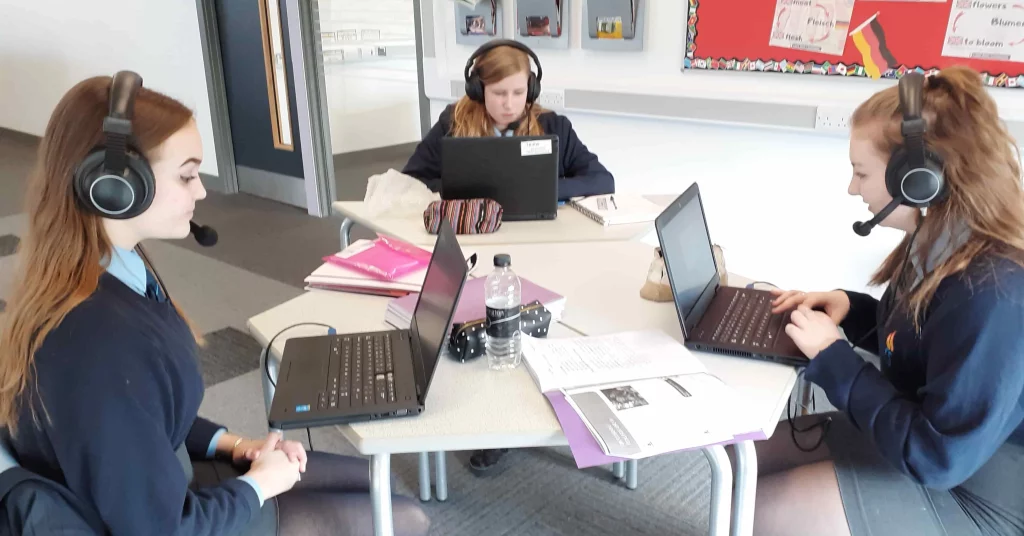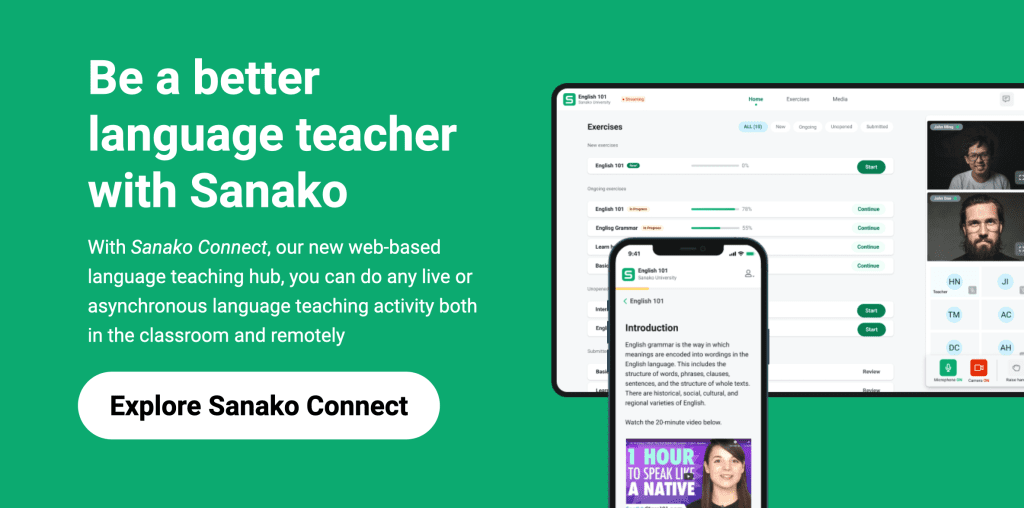For students to build fluency in their target language, it is vital that language teachers deploy the right type of pedagogical approach. The use of interactive language teaching strategies is therefore widely recommended as a compelling way to make classes increasingly focused on student participation and strongly oriented towards communication practice.
Of course, the word “interactive” has two distinct, but commonly used meanings. It refers both to communication between people and to the engagement of a user with an online or computer program. This blog post will explore how successful interactive language teaching strategies can be devised using both meanings of the word.
What are interactive language teaching strategies?
As every teacher knows, learning and teaching are not spectator sports. Students simply do not learn very much by just sitting in class listening to teachers and regurgitating information. Teachers create environments that encourage students to participate actively in their learning through verbal interaction in the teaching process.
Shariq (2017) identifies the following five core characteristics of classrooms where such active learning is being successfully deployed.
- The teacher acts as the facilitator, guiding the learners to become autonomous.
- Teaching focuses not only on correct grammatical structures but also on situations where to use them.
- Educators prepare authentic materials that address the learning needs of the students.
- Learning focuses on language functions and the ability to use them.
- Lessons use specifically designed tasks that help learners become fluent and efficient users of the target language.
So how can you use interactive language teaching strategies in your classroom?
There’s an innumerable number of ways in which educators can deploy these interactive teaching strategies in their language learning programs. We’ve highlighted five common and highly effective strategies below that maximize opportunities for communication between students. In all cases, the objective here is to encourage students to repeatedly practice key skills (listening, speaking, reading, and writing) in their target language.
1. Brainstorming or group sessions
These can be powerful techniques to get students talking about their opinions on a particular topic or issue. Using a series of educator-provided prompts, students ask and answer key questions and identify, discuss and debate the respective advantages and disadvantages of any topic. This approach also requires students to acknowledge and understand different points of view and can therefore be powerful in helping to develop their listening skills too.
2. Pair and share activities
This approach helps to extend student communication beyond simple conversation practice. Educators could give each pair a topic, a problem, or a question to work on or resolve. Students are given time to form their own conclusion which they then discuss with their pair in their own voice. Students are encouraged to question each other and argue their case before presenting their individual responses back to the whole class.
3. The one minute paper
This is a great way to bring together both speaking and writing skills. The teacher simply asks all students to spend one minute writing about a particular topic. This might be, to sum up, a topic that has been taught or just a general point of discussion.
Having written for a minute, students then share what they have written in pairs, groups, or with the whole class. It, therefore, provides an opportunity for all students to have their voice heard and not just those who are usually vocal in classroom discussions. It also facilitates discussion and debate in their target language between students.

4. Q&A sessions
This can be a great way of checking students’ understanding at the end of a unit of study and gets students to solve their peers’ questions.
Simply ask your students to anonymously jot down their questions on an index card and put them into a fishbowl. Mix them up and then read them out. See if members of the class are then able to answer the question or if they can work together to find the solution.
5. Flip your classroom with the flipped classroom method!
As outlined in this blog post on the topic, flipping your classroom could be a great interactive language teaching strategy. This approach reverses the traditional model of teaching and sees students using their own study time to review recommended resources or to do research around a particular topic or grammatical construct. As the preparation has been completed before class (online or face-to-face), the educator can then make the most of the invaluable time with their class to participate in a conversation and to complete supported activities.
The flipped classroom can be particularly powerful where educators and students have easy access to an online language learning environment. Such systems enable educators to deploy the other main type of interactive language teaching strategies – those delivered through interaction with online learning resources.
Sanako Connect is a browser-based language teaching tool and it easily allows students to interact with the teaching resources prepared and uploaded by their educators. Connect has plenty of storage space for them to attach PDFs, presentations, videos, web pages, or sound files as required. As everything is stored in the cloud, students can easily access these resources, wherever and whenever they need them.
Educators can also easily transform these simple resources into interactive language teaching activities. Connect provides educators with easily adaptable templates to collect students’ answers online. These templates apply across common language teaching strategies including multiple choice quizzes, simple Q&A text entry forms, or gap-fill exercises. They can be readily deployed to test students’ core skills, particularly listening, reading, and writing.
Sanako Connect also enables educators to quickly set up a variety of speaking tasks for students. They can either be tasked to record themselves reading aloud or responding to a pre-prepared piece of content. Alternatively, educators can create an original soundtrack, which the student then attempts to emulate using Sanako Connect’s advanced, two-track recording functionality.
Check out the video below to see how Sanako Connect’s live speaking activities can be used to assess students’ speaking skills.

Sanako’s products are specifically designed to increase the time each student spends actively practicing their core language skills during online or in-person classes. They are therefore the perfect partner for educators looking to build their students’ fluency and/or to introduce interactive language teaching strategies in every sense of the word!
If you would like to find out more about how Sanako Connect can enable your educators to deliver more impactful, interactive language teaching strategies, then contact us now to book a FREE remote demo.

